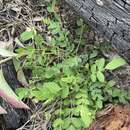Comprehensive Description
provided by North American Flora
Batidophaca villosa (Miehx.) Rydberg
Astragalus villosus Michx. Fl. Bor. Am. 2: 67. 1803. Phaca rillosa Nutt. Gen. 2: 97. 1818. Tragacantha villosa Kuntze, Rev. Gen. 949. 1891. Astragalus intonsus Sheldon. Minn. Bot. Stud. 1: 23. 1894. Tium intonsum Rydb.; Small, Fl. SE. U. S. 619, 1332. 1903.
A perennial, with a taproot and branched at the base; stems numerous, often partly subterranean, decumbent, 1-2 dm. long, pilose with long spreading white hairs; leaves spreading, 4—8 cm. long; stipules connate, green, lanceolate, attenuate, 6-9 mm. long; rachis pilose; leaflets 9-17, oval or orbicular, 5-10 mm. long, rounded or larely retuse at the apex, glabrous above, pilose beneath; peduncles 5-10 cm. long, pilose; raceme dense and short, 2-3 cm. long; bracts subulate, 2-3 mm. long; calyx long-pilose, the tube 3 mm. long, the teeth subequal, subulate, 3 mm. long; corolla cream-colored or white, 8-10 mm. long; banner obovate, rounded at the apex; wings nearly as long, the blade obliquely ovate, arcuate, longer than the claw, with a reflexed rounded auricle; keel-petals broader, 7-S mm. long; pod narrowly lanceolate in outline, arcuate, about 2 cm. long, 6 mm. wide, densely pilose, acute at each end, the upper suture acute, the lower suture sulcate, the cross-section cordate.
Type locality: Georgia.
Distribution: Florida, Georgia, and Alabama.
- bibliographic citation
- Per Axel Rydberg. 1919. (ROSALES); FABACEAE; PSORALEAE. North American flora. vol 24(1). New York Botanical Garden, New York, NY
Physical Description
provided by USDA PLANTS text
Perennial, Herbs, Stems woody below, or from woody crown or caudex , Plants with rhizomes or suckers, Nodules present, Stems prostrate, trailing, or mat forming, Stems less than 1 m tall, Stems solid, Stems or young twigs sparsely to densely hairy, Stem hairs hispid to villous, Leaves alternate, Leaves petiolate, Stipules conspicuous, Stipules green, triangulate to lanceolate or foliaceous, Stipules membranous or chartaceous, Stipules persistent, Stipules free, Leaves compound, Leaves odd pinnate, Leaf or leaflet margins entire, Leaflets opposite, Leaflets 10-many, Leaves hairy on one or both surfaces, Inflorescences racemes, Inflorescence axillary, Inflorescence or flowers lax, declined or pendulous, Bracts very small, absent or caducous, Flowers zygomorphic, Calyx 5-lobed, Calyx hairy, Petals separate, Corolla papilionaceous, Petals clawed, Petals ochroleucous, cream colored, Petals greenish yellow, Banner petal narrow or oblanceolate, Wing petals narrow, oblanceolate to oblong, Wing tips obtuse or rounded, Keel petals auriculate, spurred , or gibbous, Keel tips obtuse or rounded, not beaked, Stamens 9-10, Stamens diadelphous, 9 united, 1 free, Filaments glabrous, Style terete, Style persistent in fruit, Fruit a legume, Fruit stipitate, Fruit unilocular, Fruit humistrate, lying on the ground, Fruit freely dehiscent, Fruit tardily or weakly dehiscent, Fruit elongate, straight, Fruit oblong or ellipsoidal, Fruit exserted from calyx, Fruit beaked, Fruit hairy, Fruit 11-many seeded, Seeds cordiform, mit-shaped, notched at one end, Seed surface smooth, Seeds olive, brown, or black.

